Monitoring Wise Use of Wetlands During Land Conversion for the Ramsar Convention on Wetlands: A Case Study of the Contiguous United States of America (USA)
Abstract
1. Introduction
1.1. Background Information About the Ramsar Convention
- “The wise use of wetlands is their sustainable utilization for the benefit of humankind in a way compatible with the maintenance of the natural properties of the ecosystem”.
- Sustainable utilization is defined as “human use of a wetland so that it may yield the greatest continuous benefit to present generations while maintaining its potential to meet the needs and aspirations of future generations”.
- Natural properties of the ecosystem are defined as “those physical, biological or chemical components, such as soil, water, plants, animals and nutrients, and the interactions between them”.
1.2. Brief History of Wetlands Losses in the United States of America (USA)
1.3. Brief Literature Review and Objectives of the Study
2. Materials and Methods
2.1. Study Area
2.2. Geospatial Analysis
3. Results
3.1. Historical (1780) Wetlands Soil Carbon (C) Stocks and Social Costs of C (SC-CO2)
3.2. Historical Wetlands Losses and Damages (1780–1980) in the Contiguous United States of America (USA)
3.3. Recent Wetlands Changes to Non-Wetlands Land Cover Types During Land Conversions (2001–2021) in the Contiguous United States of America (USA)
3.4. Damages from Recent Wetlands Losses to Developments (2001–2021) in the Contiguous United States of America (USA)
3.5. The Importance of Disaggregating Wetlands Change Analysis by Smaller Units
4. Discussion
4.1. Significance of the Results for the Ramsar Convention on Wetlands
4.1.1. Benefits and Limitations of the Ramsar Convention (RC)
4.1.2. Refining the Ramsar Convention
4.2. Significance of the Results to the United Nations (UN) Sustainable Development Goals (SDGs) and Other UN Initiatives
- SDG 2: Zero Hunger contains Target 2.4, which mentions sustainable food production systems and maintenance of ecosystems necessary for climate change adaptation, flooding, and improving soil and land quality [38]. Historic wetlands loss (53% area loss) was primarily caused by agriculture expansion in the contiguous USA, which altered the hydrological cycle and caused GHG emissions, contributing to climate change. Recent wetlands losses (2001–2021) in all states of the contiguous USA are also partially caused by agricultural conversions of wetlands to hay/pasture and cultivated crops (2265.5 km2) (Table 1). (Relevant for UN SDG 2: Zero Hunger, Target 2.4);
- SDG 3: Good Health and Well-Being contains Target 3.9, which highlights the need to reduce the number of illnesses and deaths from pollution, including soil pollution [38]. Historic and recent wetlands losses reduced the “filtering” capacity of soils and land to purify water in all states of the contiguous USA. (Relevant for UN SDG 3: Good Health and Well-Being, Target 3.9);
- SDG 6: Clean Water and Sanitation contains several targets for safe drinking water and its sources, including wetlands [38]. The filtering capacity of soil in the contiguous US was greatly reduced when wetlands were drained and converted to other land uses, directly impacting water quality. (Relevant for UN SDG 6: Clean Water and Sanitation, Targets 6.1, 6.3, 6.4, and 6.6);
- SDG 11: Sustainable Cities and Communities require the mitigation of risks to build resilience, and the loss of inland and coastal wetlands between 2000 and 2021 increased flood risk because wetlands serve as a buffer to extreme precipitation and weather events. For example, some of the states with the highest wetlands loss were the coastal states of FL, TX, and LA (Figure 8), where this loss reduced the sustainability and resilience of cities and communities in these states. (Relevant for UN SDG 11: Sustainable Cities and Communities, Target 11.B);
- SDG 12: Responsible Consumption and Production and Target 12.2 highlight the need for efficient use and sustainable management of natural resources. Our study documents historical and recent unsustainable use of wetlands by converting them into agriculture and urban developments in the contiguous USA. (Relevant for UN SDG 12: Responsible Consumption and Production, Target 12.2);
- SDG 13: Climate Action and Target 13.1 urging to act on climate change and its impacts, but most states in the USA have no climate change plans (https://www.georgetownclimate.org/adaptation/plans.html (accessed on 16 January 2025)) [45]. Data from this study can support the development of a plan for the states because it determined soil-based GHG emissions and associated SC-CO2 values from the conversion of wetlands to developments in the past and present. In addition, this study quantified the loss of potential soil C sequestration from wetlands losses. Our study showed that almost 53% of the wetlands area was lost between 1780 and 1980, starting with 894,880.7 km2 in 1780 and falling to 422,388.2 km2 in 1980. This net loss generated damages, including midpoint total soil C loss (6.7 × 1013 kg of C) with associated midpoint “realized” social costs of C (SC-CO2) value of $11.4T (where T = trillion = 1012, $ = United States dollars, USD). These losses were highly variable within the country, with the states of Florida (FL), Texas (TX), and Louisiana (LA) experiencing the largest losses of wetlands area and C with associated SC-CO2 values. (Relevant to UN SDG 13: Climate Action, Target 13.1);
- Wetlands losses in the contiguous USA contributed to biodiversity loss, which is not consistent with the wise use of wetlands obligations under the RC. In addition, the continued loss of wetlands is altering the hydrological cycle contributing to further land degradation and desertification. Tracking wetlands losses is also important for UNCCD because wetlands are hotspots of soil C, which can be released upon disturbance. The results of our study suggest that it is important to disaggregate land degradation and land degradation neutrality analyses by LULC type to see wetlands degradation status. (Relevant to UN SDG 15: Life on Land, Targets 15.1, 15.5, and 15.A; UN Convention to Combat Desertification (UNCCD); UN Convention on Biological Diversity; UN Kunming–Montreal Global Biodiversity Framework);
- The Revised World Soil Charter, which was endorsed by member states of the Food and Agriculture Organization (FAO), provides guidelines to ensure that “soils are managed sustainably and that degraded soils are rehabilitated or restored” [43]. Our study showed losses of wetlands which often contain the soil order of Histosols, soils high in soil organic matter, which become hotspots of GHG emissions upon disturbance (e.g., drainage of wetlands, etc.). (Relevant to The Revised World Soil Charter).
4.3. Significance of the Results for the Millennium Ecosystem Assessment and Consideration of Additional Losses and Damages (L&D)
4.4. Limitations of the Study and Future Research Needs
5. Conclusions
Supplementary Materials
Author Contributions
Funding
Data Availability Statement
Acknowledgments
Conflicts of Interest
Glossary
| C | Carbon |
| CO2 | Carbon dioxide |
| EPA | Environmental Protection Agency |
| ES | Ecosystem services |
| FL | Florida |
| GHG | Greenhouse gas |
| LA | Louisiana |
| L&D | Loss and damage |
| LULC | Land use/land cover |
| MRLC | Multi-Resolution Land Characteristics Consortium |
| N | North |
| NLCD | National Land Cover Database |
| NRCS | Natural Resources Conservation Service |
| RC | Ramsar Convention |
| SC-CO2 | Social costs of carbon emissions |
| SDGs | Sustainable Development Goals |
| SSURGO | Soil Survey Geographic Database |
| STATSGO | State Soil Geographic Database |
| TX | Texas |
| UN | United Nations |
| UNCCD | United Nations Convention to Combat Desertification |
| USA | United States of America |
| USDA | United States Department of Agriculture |
| W | West |
References
- Xu, X.; Chen, M.; Yang, G.; Jiang, B.; Zhang, J. Wetland ecosystem services research: A critical review. Glob. Ecol. Conserv. 2020, 22, e01027. [Google Scholar] [CrossRef]
- Convention on Wetlands of International Importance Especially as Waterfowl Habitat. Ramsar, Iran, 2.2.1971. Available online: https://www.ramsar.org/sites/default/files/documents/library/current_convention_text_e.pdf (accessed on 1 January 2025).
- Ramsar: The Convention on Wetlands. Official Documents. Available online: https://www.ramsar.org/official-documents (accessed on 1 January 2025).
- Recommendation 3.3: Wise Use of Wetlands. 3rd Meeting of the Conference of the Contracting Parties, Regina, Canada, 27 May–5 June 1987. Available online: https://www.ramsar.org/sites/default/files/documents/library/key_rec_3.03e.pdf (accessed on 5 January 2025).
- Podolsky, M.J. US wetlands policy, legislation, and case law as applied to the wise use concept of the Ramsar convention. Case W. Res. L. Rev. 2001, 52, 627. [Google Scholar]
- Ramsar Monitoring Website. Global Standard for Wetland Conservation. Available online: https://ramsar-monitoring.org/# (accessed on 5 January 2025).
- Ramsar Country Profile: United States of America. Available online: https://www.ramsar.org/country-profile/united-states-america (accessed on 5 January 2025).
- Dahl, T.E. Wetland Losses in the United States 1780’s to 1980’s. U.S. Department of Interior FWS; 1990. Available online: https://www.fws.gov/sites/default/files/documents/Wetlands-Losses-in-the-United-States-1780s-to-1980s.pdf (accessed on 5 January 2025).
- Maltby, E. The wetlands paradigm shift in response to changing societal priorities: A reflective review. Land 2022, 11, 1526. [Google Scholar] [CrossRef]
- Ruhl, J.B.; James Salzman, J. No net loss? The past, present, and future of wetlands mitigation banking. Case W. Res. L. Rev. 2022, 73, 411–439. Available online: https://scholarlycommons.law.case.edu/caselrev/vol73/iss2/8 (accessed on 5 January 2025).
- Lang, M.W.; Ingebritsen, J.C.; Griffin, R.K. Status and Trends of Wetlands in the Conterminous United States 2009 to 2019; U.S. Department of the Interior; Fish and Wildlife Service: Washington, DC, USA, 2024; 43p. Available online: https://www.fws.gov/media/status-and-trends-wetlands-conterminous-united-states-2009-2019 (accessed on 5 January 2025).
- Dahl, T.E. Status and Trends of Wetlands in the Conterminous United States 2004 to 2009; U.S. Department of the Interior; Fish and Wildlife Service: Washington, DC, USA, 2011; 108p. [Google Scholar]
- Atesoglu, A.; Ozel, H.B.; Varol, T.; Cetin, M.; Baysal, B.U.; Bulut, F.S. Monitoring land cover/use conversions in Türkiye wetlands using Collect Earth. J. Indian Soc. Remote Sens. 2025, 1–16. [Google Scholar] [CrossRef]
- Shinkarenko, S.S.; Bartalev, S.A. Application of remote sensing data in large-scale monitoring of wetlands. Cosm. Res. 2024, 62 (Suppl. S1), S100–S114. [Google Scholar] [CrossRef]
- Dahanayake, H.D.; Dahanayaka, D.D.G.L.; Hudson, P.; Wickramasinghe, D. Land use changes of coastal wetlands using remote sensing. A case study of Muthurajawela & Anawilundawa wetlands, Sri Lanka. TeMA-J. Land Use Mobil. Environ. 2024, 17, 7–21. [Google Scholar] [CrossRef]
- Multi-Resolution Land Characteristics Consortium—MRLC. Available online: https://www.mrlc.gov/ (accessed on 5 January 2025).
- EPA—United States Environmental Protection Agency. The Social Cost of Carbon. EPA Fact Sheet. 2016. Available online: https://19january2017snapshot.epa.gov/climatechange/social-cost-carbon_.html (accessed on 5 January 2025).
- ESRI (Environmental Systems Research Institute). ArcGIS Pro 3.1. Available online: https://www.esri.com/en-us/arcgis/products/arcgis-pro/overview (accessed on 24 December 2024).
- US Census Bureau, Geography Division. Available online: https://www.census.gov/geographies/mapping-files/time-series/geo/carto-boundary-file.html (accessed on 24 December 2024).
- Guo, Y.; Amundson, R.; Gong, P.; Yu, Q. Quantity and spatial variability of soil carbon in the conterminous United States. Soil Sci. Soc. Am. J. 2006, 70, 590–600. [Google Scholar] [CrossRef]
- Asselen, S.V.; Verburg, P.H.; Vermaat, J.E.; Janse, J.H. Drivers of wetland conversion: A global meta-analysis. PLoS ONE 2013, 8, e81292. [Google Scholar] [CrossRef]
- Zou, Z.; Huang, C.; Lang, M.W.; Du, L.; McCarty, G.; Ingebritsen, J.C.; Harner, J.; Griffin, R.; Gong, W.; Lu, J. Hotspots of wetland loss to impervious surfaces in the conterminous United States. Sci. Total Environ. 2024, 948, 174787. [Google Scholar] [CrossRef]
- Enwright, N.M.; Osland, M.J.; Thorne, K.M.; Guntenspergen, G.R.; Grace, J.B.; Steyer, G.D.; Herold, N.; Chivoiu, B.; Han, M. Observing coastal wetland transitions using national land cover products. Prog. Phys. Geogr. 2024, 48, 113–135. [Google Scholar] [CrossRef]
- Moomaw, W.R.; Chmura, G.L.; Davies, G.T.; Finlayson, C.M.; Middleton, B.A.; Natali, S.M.; Perry, J.E.; Roulet, N.; Sutton-Grier, A.E. Wetlands in a changing climate: Science, policy and management. Wetlands 2018, 38, 183–205. [Google Scholar] [CrossRef]
- Nahlik, A.M.; Fennessy, M.S. Carbon storage in US wetlands. Nat. Commun. 2016, 7, 1–9. [Google Scholar] [CrossRef] [PubMed]
- Tan, L.; Ge, Z.; Ji, Y.; Lai, D.Y.; Temmerman, S.; Li, S.; Li, X.; Tang, J. Land use and land cover changes in coastal and inland wetlands cause soil carbon and nitrogen loss. Glob. Ecol. Biogeogr. 2022, 31, 2541–2563. [Google Scholar] [CrossRef]
- Revesz, R.L.; Sarinsky, M. The social cost of greenhouse gases: Legal economic, and institutional perspective. Yale J. Reg. 2022, 39, 856–907. [Google Scholar]
- Bullock, A.; Acreman, M. The role of wetlands in the hydrological cycle. Hydrol. Earth Syst. Sci. 2003, 7, 358–389. [Google Scholar] [CrossRef]
- Gallant, K.; Withey, P.; Risk, D.; Kooten, G.C.; Spafford, L. Measurement and economic valuation of carbon sequestration in Nova Scotian wetlands. Ecol. Econ. 2020, 171, 106619. [Google Scholar] [CrossRef]
- Brody, S.D.; Zahran, S.; Maghelal, P.; Grover, H.; Highfield, W.E. The rising costs of floods: Examining the impact of planning and development decisions on property damage in Florida. J. Am. Plan. Assoc. 2007, 73, 330–345. [Google Scholar] [CrossRef]
- U.S. Geological Survey (USGS). Aerial Photography-Digital Orthophoto Quadrangle (DOQs). Retrieved from USGS Earth Explorer; 2005. Available online: https://www.usgs.gov/centers/eros/science/usgs-eros-archive-aerial-photography-digital-orthophoto-quadrangle-doqs (accessed on 17 January 2025).
- U.S. Geological Survey (USGS). National Agriculture Imagery Program (NAIP). Retrieved from USGS Earth Explorer; 2021. Available online: https://www.usgs.gov/centers/eros/science/usgs-eros-archive-aerial-photography-national-agriculture-imagery-program-naip (accessed on 17 January 2025).
- Mohanty, S.; Pandey, P.C.; Pandey, M.; Srivastava, P.K.; Dwivedi, C.S. Wetlands contribution and linkage to support SDGs, its indicators and targets—A critical review. Sustain. Dev. 2024, 32, 5348–5392. [Google Scholar] [CrossRef]
- Ballut-Dajud, G.A.; Sandoval Herazo, L.C.; Fernández-Lambert, G.; Marín-Muñiz, J.L.; López Méndez, M.C.; Betanzo-Torres, E.A. Factors affecting wetland loss: A review. Land 2022, 11, 434. [Google Scholar] [CrossRef]
- Dronova, I. Object-based image analysis in wetland research: A review. Remote Sens. 2015, 7, 6380–6413. [Google Scholar] [CrossRef]
- Zheng, J.Y.; Hao, Y.Y.; Wang, Y.C.; Zhou, S.Q.; Wu, W.B.; Yuan, Q.; Gao, Y.; Guo, H.Q.; Cai, X.X.; Zhao, B. Coastal wetland vegetation classification using pixel-based, object-based and deep learning methods based on RGB-UAV. Land 2022, 11, 2039. [Google Scholar] [CrossRef]
- Vriesinga, S. International wetland conservation and the Ramsar Convention: Do broad measures and wise use equal meaningful transboundary solutions. Southeast. Environ. Law J. 2008, 17, 169. Available online: https://scholarcommons.sc.edu/selj/vol17/iss1/5 (accessed on 5 January 2025).
- United Nations (UN). Transforming Our World: The 2030 Agenda for Sustainable Development; The Resolution Adopted by the General Assembly on 25 September 2015; United Nations: New York, NY, USA, 2015; 35p. [Google Scholar]
- Seifollahi-Aghmiuni, S.; Nockrach, M.; Kalantari, Z. The potential of wetlands in achieving the sustainable development goals of the 2030 Agenda. Water 2019, 11, 609. [Google Scholar] [CrossRef]
- UN. Convention on Biological Diversity. Treaty Collection. 1992. Available online: https://www.cbd.int/doc/legal/cbd-en.pdf (accessed on 16 January 2025).
- United Nations Convention to Combat Desertification Overview. Available online: https://www.unccd.int/convention/overview (accessed on 16 January 2025).
- United Nations (UN) Convention to Combat Desertification. Decision 3/COP.12 (COP 12, Ankara, 2015). Integration of the Sustainable Development Goals and Target into the Implementation of the United Nations Convention to Combat Desertification and the Intergovernmental Working Group Report on Land Degradation Neutrality. Available online: https://www.unccd.int/official-documents/cop-12-ankara-2015 (accessed on 16 January 2025).
- Food and Agriculture Organization (FAO). Revised World Soil Charter. Available online: https://openknowledge.fao.org/server/api/core/bitstreams/65be618a-f5e8-4f67-9cbb-d77f1f5cd31e/content (accessed on 16 January 2025).
- UN. Convention on Biological Diversity. Kunming-Montreal Global Biodiversity Framework. 2022. Available online: https://www.cbd.int/article/cop15-final-text-kunming-montreal-gbf-221222 (accessed on 16 January 2025).
- Georgetown Law. Georgetown Climate Center. State Adaptation Progress Tracker. Available online: https://www.georgetownclimate.org/adaptation/plans.html (accessed on 16 January 2025).
- Mitsch, W.J.; Bernal, B.; Hernandez, M.E. Ecosystem services of wetlands. Int. J. Biodivers. Sci. Ecosyst. Serv. Manag. 2015, 11, 1–4. [Google Scholar] [CrossRef]
- Costanza, R.; d’Arge, R.; De Groot, R.; Farber, S.; Grasso, M.; Hannon, B.; Limburg, K.; Naeem, S.; O’neill, R.V.; Paruelo, J.; et al. The value of the world’s ecosystem services and natural capital. Nature 1997, 387, 253–260. [Google Scholar] [CrossRef]
- De Groot, R.; Brander, L.; Van Der Ploeg, S.; Costanza, R.; Bernard, F.; Braat, L.; Christie, M.; Crossman, N.; Ghermandi, A.; Hein, L.; et al. Global estimates of the value of ecosystems and their services in monetary units. Ecosyst. Serv. 2012, 1, 50–61. [Google Scholar] [CrossRef]
- Costanza, R.; De Groot, R.; Sutton, P.; Van der Ploeg, S.; Anderson, S.J.; Kubiszewski, I.; Farber, S.; Turner, R.K. Changes in the global value of ecosystem services. Global Environ. Change 2014, 26, 152–158. [Google Scholar] [CrossRef]
- Millennium Ecosystem Assessment. Ecosystems and Human Well-Being: Synthesis; Island Press: Washington, DC, USA, 2005. [Google Scholar]
- Zhang, Y.; Zhang, X.; Fang, W.; Cai, Y.; Zhang, G.; Liang, J.; Chang, J.; Chen, L.; Wang, H.; Zhang, P.; et al. Carbon sequestration potential of wetlands and regulating strategies response to climate changes. Environ. Res. 2025, 269, 120890. [Google Scholar] [CrossRef]
- Liu, X.; Lu, X.; Yu, R.; Sun, H.; Xue, H.; Qi, Z.; Cao, Z.; Zhang, Z.; Liu, T. Greenhouse gases emissions from riparian wetlands: An example from the Inner Mongolia grassland region in China. Biogeosciences 2021, 18, 4855–4872. [Google Scholar] [CrossRef]
- Rosenblum, Z.H.; Schmeier, S. Global wetland governance: Introducing the transboundary wetlands database. Water 2022, 14, 3077. [Google Scholar] [CrossRef]
- Vynne, C.; Dovichin, E.; Fresco, N.; Dawson, N.; Joshi, A.; Law, B.E.; Lertzman, K.; Rupp, S.; Schmiegelow, F.; Trammell, E.J. The importance of Alaska for climate stabilization, resilience, and biodiversity conservation. Front. For. Glob. Change 2021, 4, 701277. [Google Scholar] [CrossRef]
- Hinzman, L.D.; Bettez, N.D.; Bolton, W.R.; Chapin, F.S.; Dyurgerov, M.B.; Fastie, C.L.; Griffith, B.; Hollister, R.D.; Hope, A.; Huntington, H.P.; et al. Evidence and implications of recent climate change in northern Alaska and other arctic regions. Clim. Change 2005, 72, 251–298. [Google Scholar] [CrossRef]
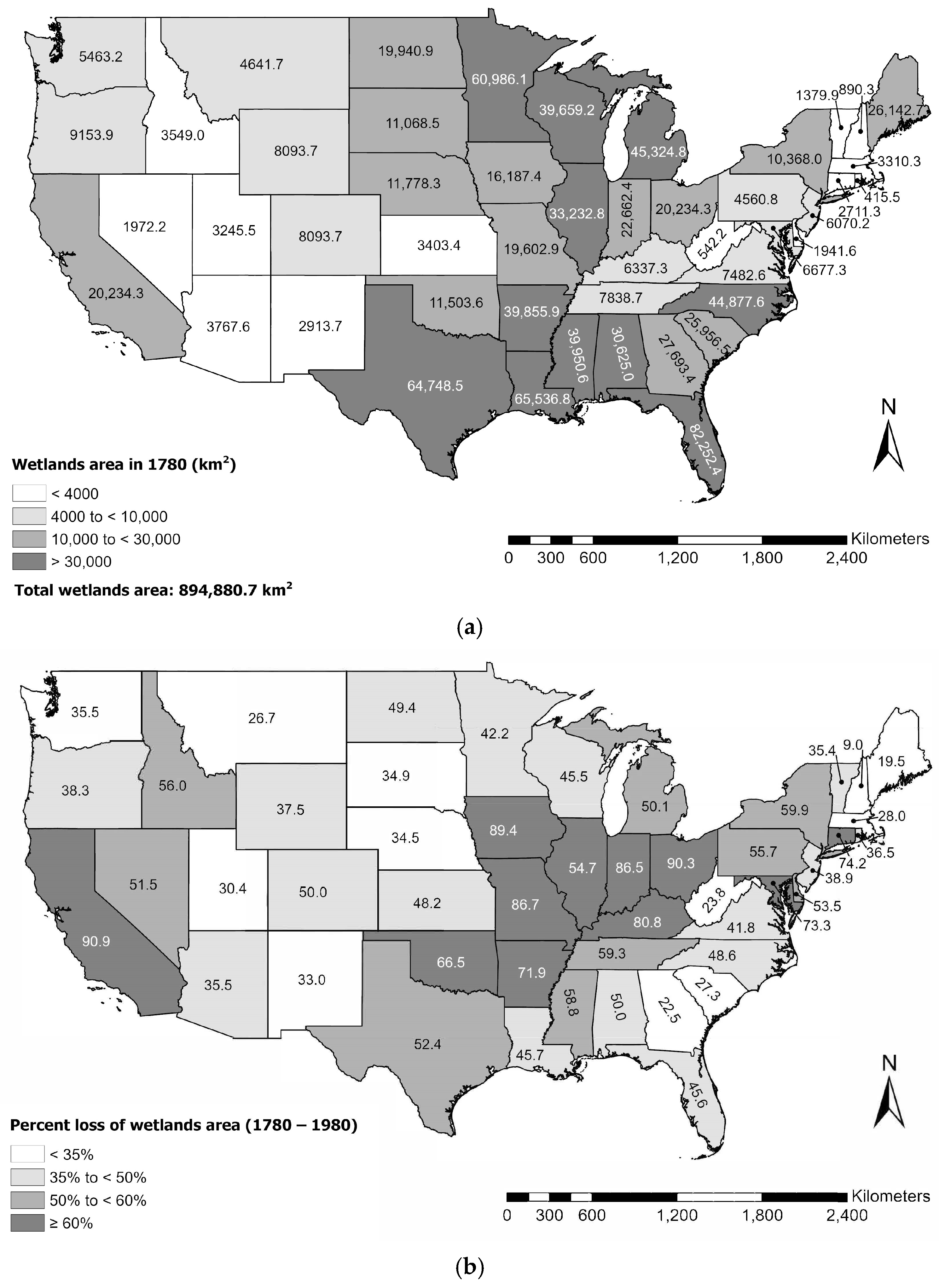

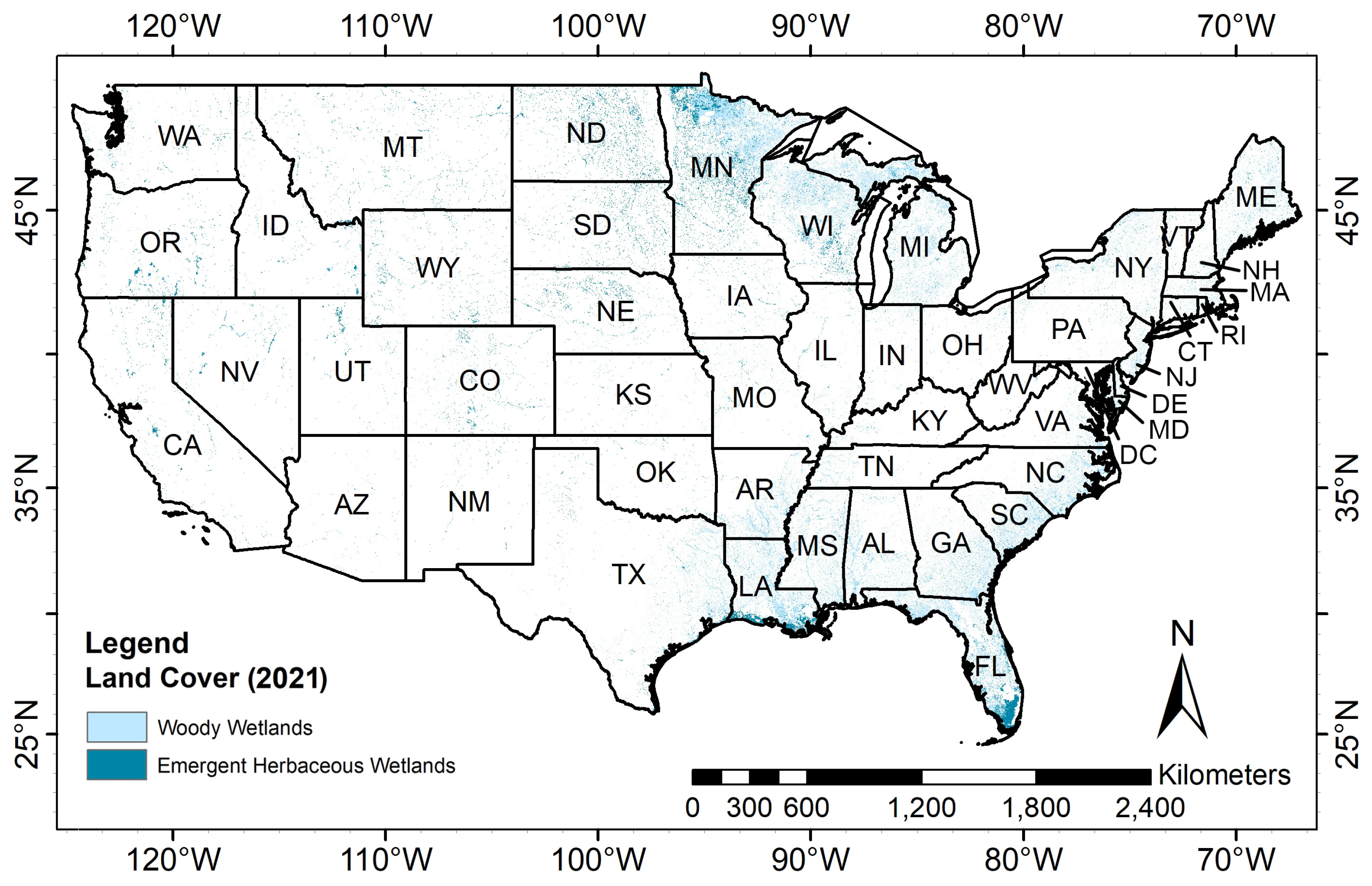
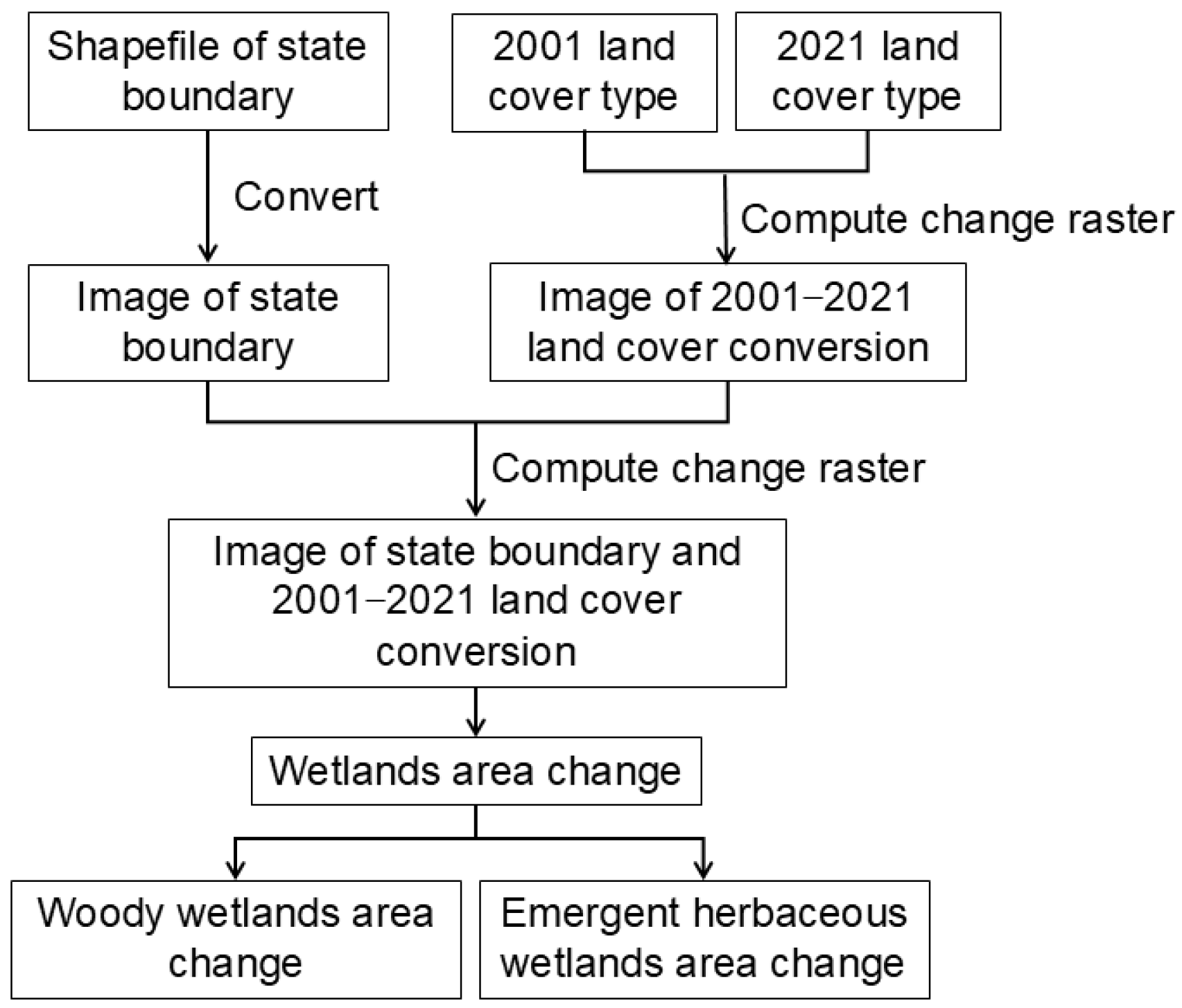
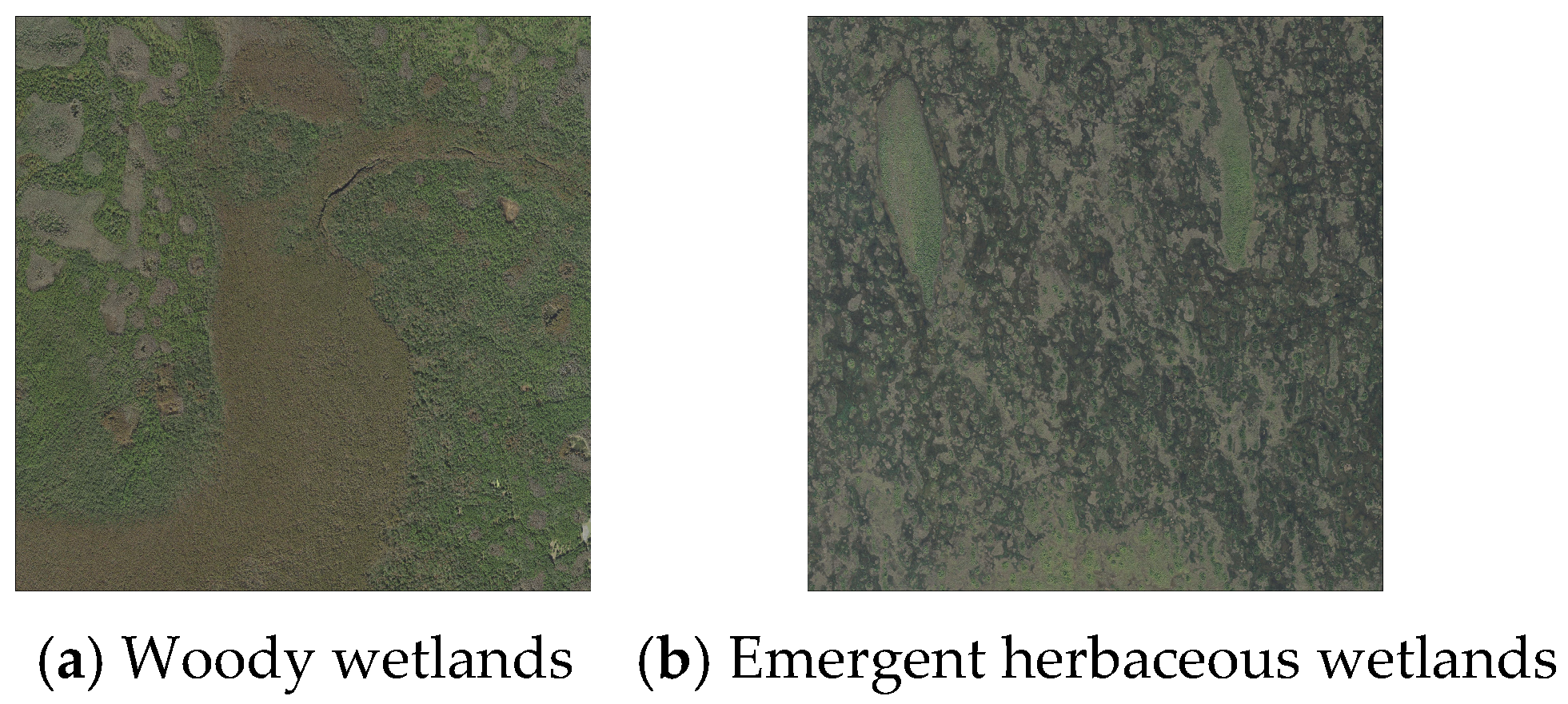
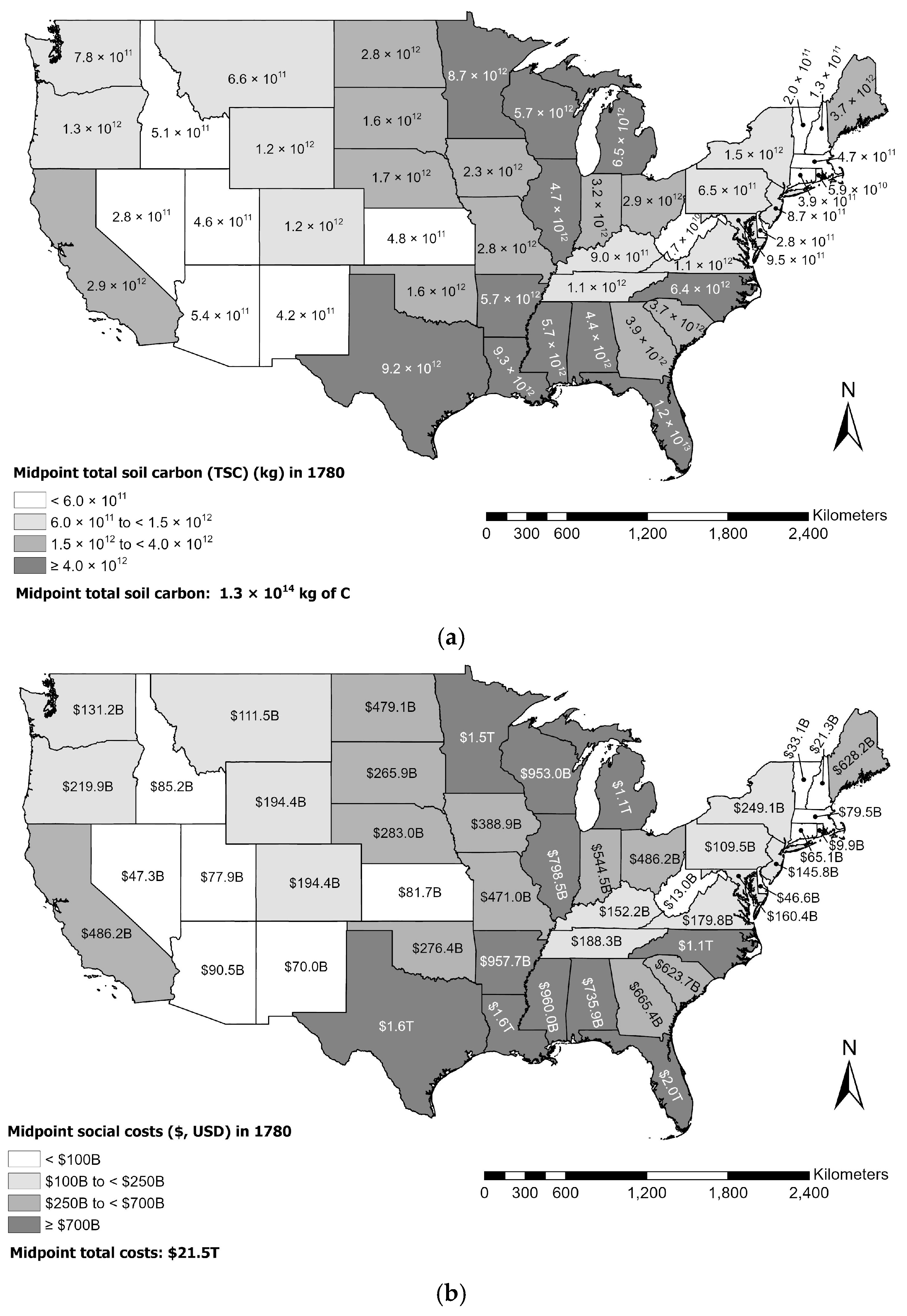


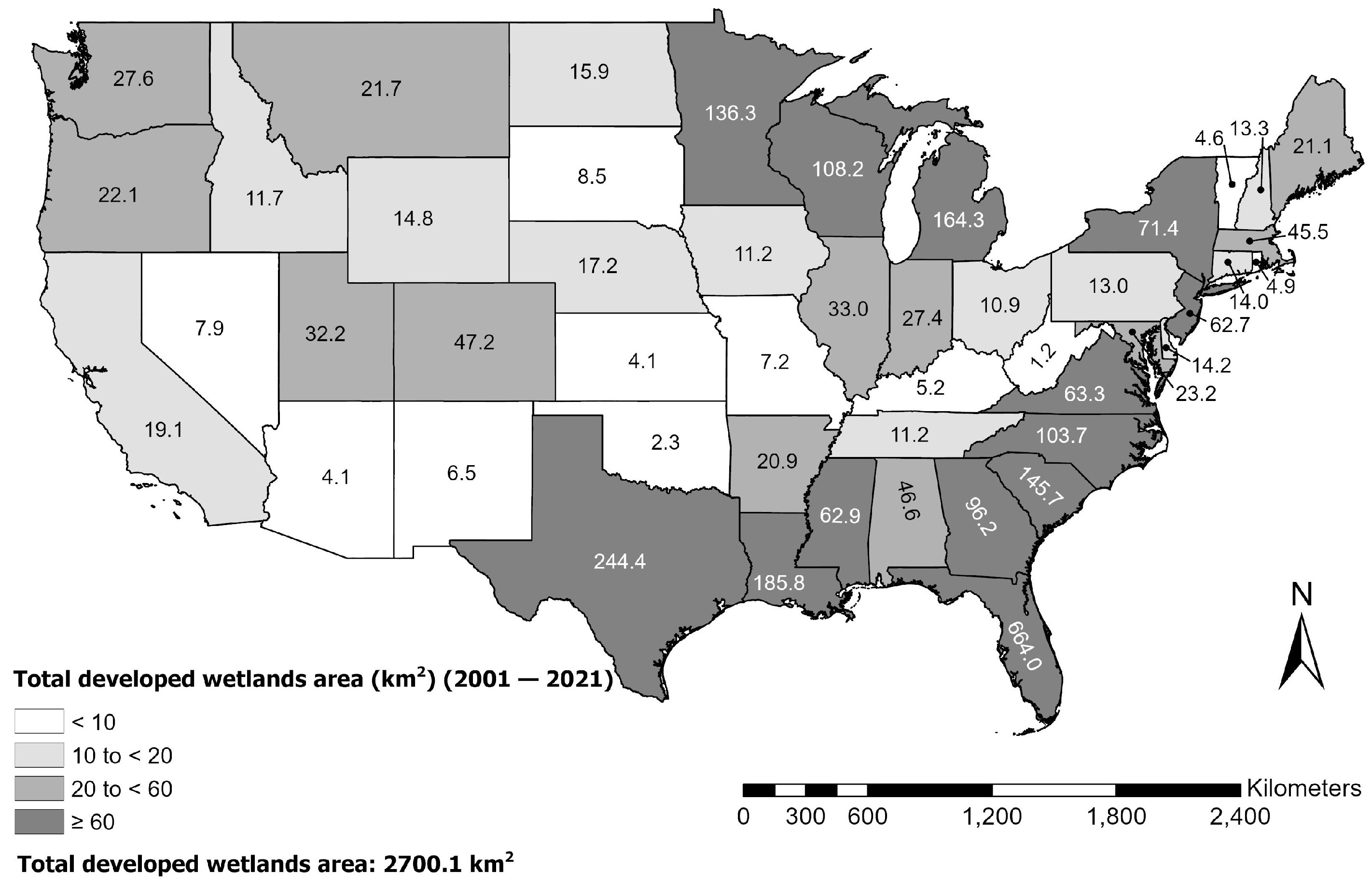
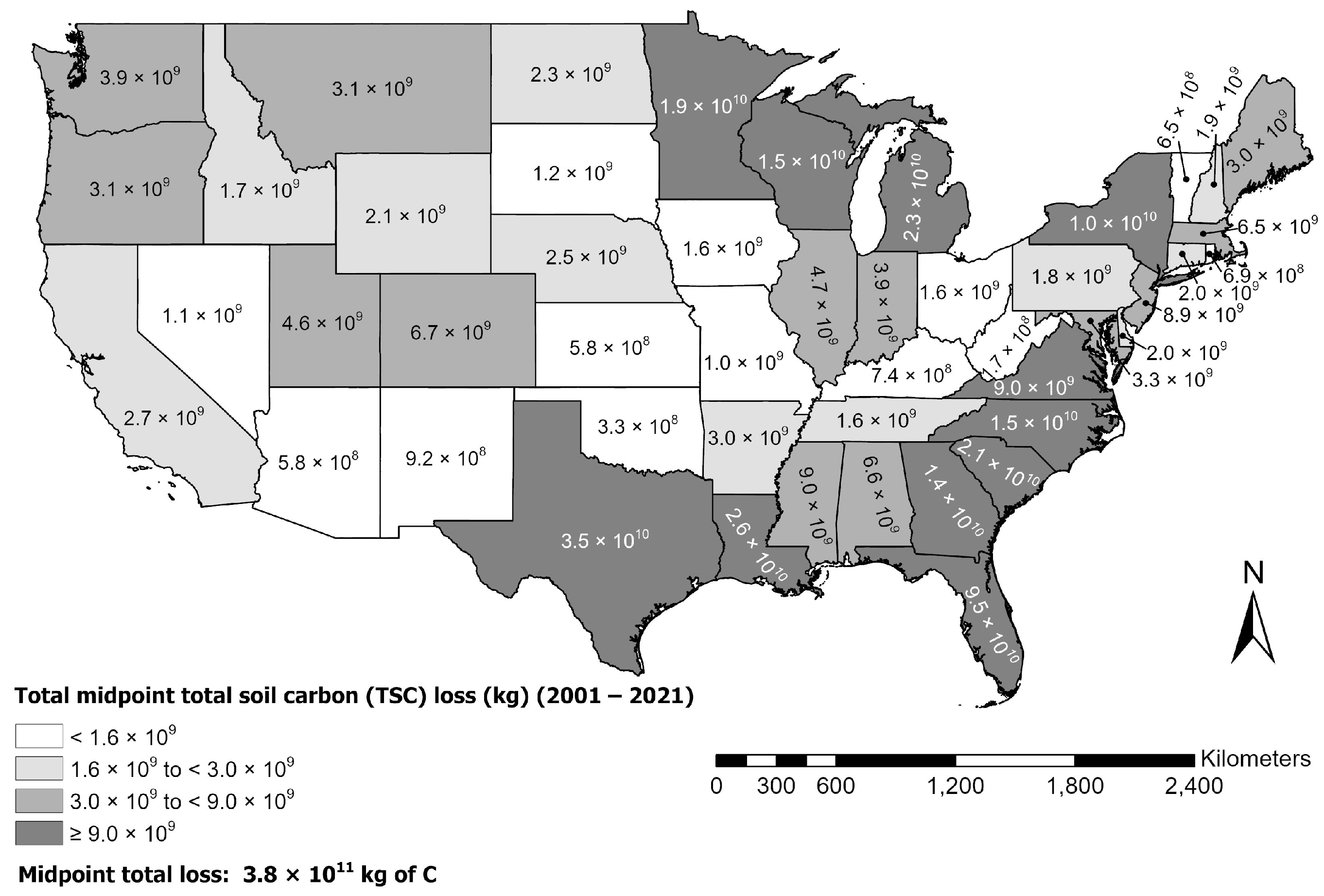
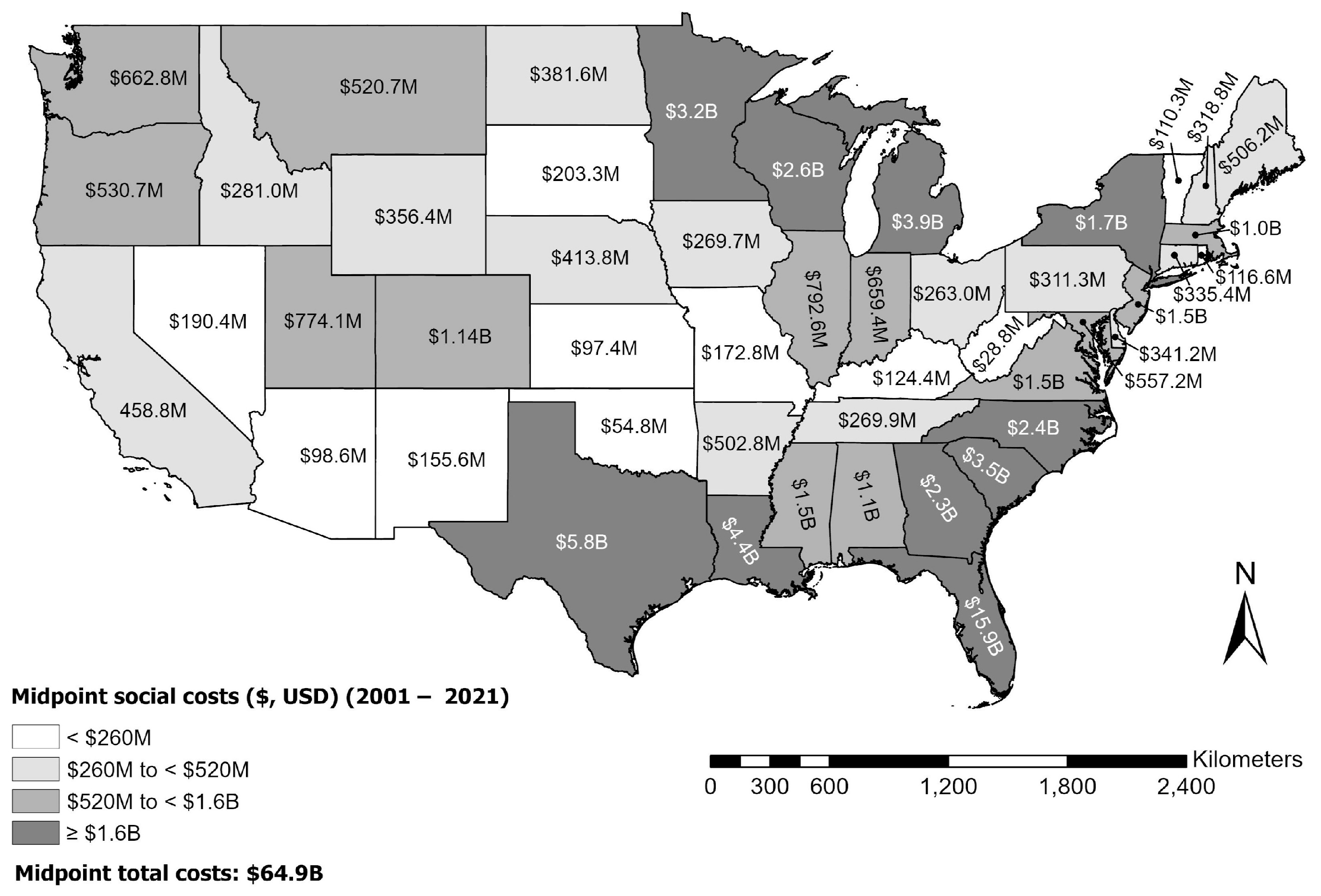
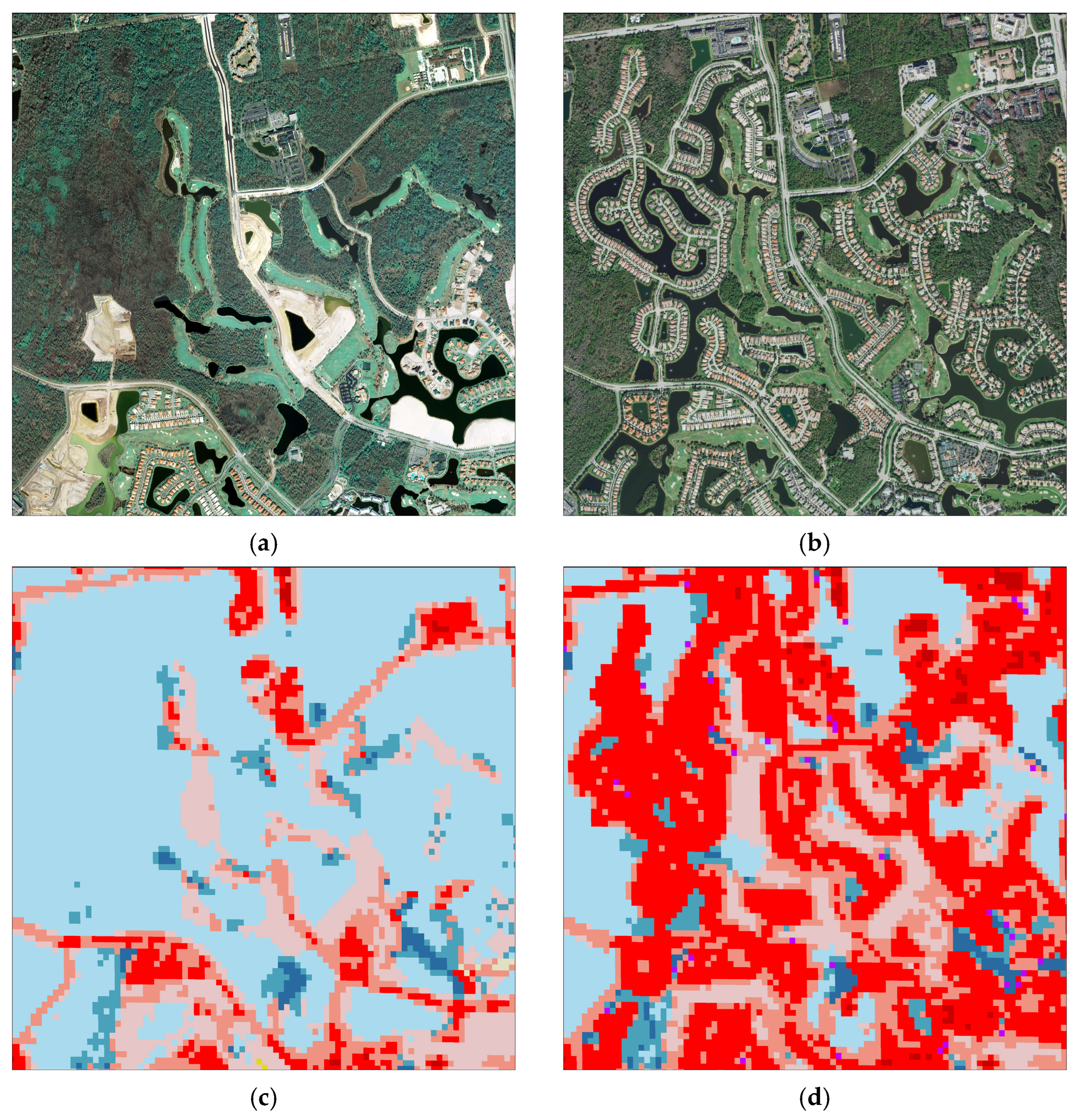
| NLCD Land Cover Classes (LULC) | Area (km2) in 2001 | Total Wetlands Area (km2) in 2021; Change (2001–2021) (km2) | Woody Wetlands Area (km2) in 2021 | Emergent Herbaceous Wetlands Area (km2) in 2021 |
|---|---|---|---|---|
| Total wetlands | 465,148.1 | 458,639.2 (−6508.8) | 347,499.9 | 111,139.3 |
| Woody wetlands | 350,376.8 | 348,324.7 | 336,398.0 | 11,926.7 |
| Emergent herbaceous wetlands | 114,771.3 | 110,314.5 | 11,101.9 | 99,212.6 |
| − | − | Change in the Wetlands Area (2001–2021) (km2) to Non-Wetland Types | ||
| Shrub/Scrub | − | +175.5 | +71.8 | +103.7 |
| Mixed forest | − | +93.3 | +50.5 | +42.8 |
| Deciduous forest | − | +283.0 | +87.3 | +195.7 |
| Herbaceous | − | +388.3 | +60.8 | +327.5 |
| Evergreen forest | − | +258.5 | +128.3 | +130.2 |
| Hay/Pasture | − | +577.6 | +63.0 | +514.7 |
| Cultivated crops | − | +1687.9 | +268.8 | +1419.0 |
| Developed, open space | − | +1302.6 | +1046.4 | +256.2 |
| Developed, low intensity | − | +692.8 | +506.8 | +186.0 |
| Developed, medium intensity | − | +535.1 | +388.0 | +147.2 |
| Developed, high intensity | − | +169.6 | +118.1 | +51.4 |
| Barren land | − | +344.6 | +87.0 | +257.6 |
| NLCD Land Cover Classes (LULC) | Area (km2) in 2001 | Total Wetlands Area (km2) in 2021; Change (2001–2021) (km2) | Woody Wetlands Area (km2) in 2021 | Emergent Herbaceous Wetlands Area (km2) in 2021 |
|---|---|---|---|---|
| Total wetlands | 52,125.7 | 51,362.1 (−763.7) | 37,121.1 | 14,241.0 |
| Woody wetlands | 36,913.7 | 36,308.3 | 34,819.6 | 1488.7 |
| Emergent herbaceous wetlands | 15,212.1 | 15,053.7 | 2301.5 | 12,752.2 |
| − | − | Change in the Wetlands Area (2001–2021) (km2) to Non-Wetland Types | ||
| Shrub/Scrub | − | +7.3 | +4.7 | +2.6 |
| Mixed forest | − | +1.2 | +0.7 | +0.5 |
| Deciduous forest | − | +0.7 | +0.4 | +0.3 |
| Herbaceous | − | +5.4 | +2.9 | +2.5 |
| Evergreen forest | − | +28.9 | +16.2 | +12.7 |
| Hay/Pasture | − | +5.9 | +3.4 | +2.5 |
| Cultivated crops | − | +16.8 | +12.4 | +4.4 |
| Developed, open space | − | +254.8 | +220.4 | +34.4 |
| Developed, low intensity | − | +181.9 | +145.8 | +36.1 |
| Developed, medium intensity | − | +172.2 | +135.7 | +36.4 |
| Developed, high intensity | − | +55.0 | +42.0 | +13.1 |
| Barren land | − | +33.5 | +20.7 | +12.8 |
Disclaimer/Publisher’s Note: The statements, opinions and data contained in all publications are solely those of the individual author(s) and contributor(s) and not of MDPI and/or the editor(s). MDPI and/or the editor(s) disclaim responsibility for any injury to people or property resulting from any ideas, methods, instructions or products referred to in the content. |
© 2025 by the authors. Licensee MDPI, Basel, Switzerland. This article is an open access article distributed under the terms and conditions of the Creative Commons Attribution (CC BY) license (https://creativecommons.org/licenses/by/4.0/).
Share and Cite
Mikhailova, E.A.; Zurqani, H.A.; Lin, L.; Hao, Z.; Post, C.J.; Schlautman, M.A.; Post, G.C.; Brown, C.E.; Shepherd, G.B. Monitoring Wise Use of Wetlands During Land Conversion for the Ramsar Convention on Wetlands: A Case Study of the Contiguous United States of America (USA). Biosphere 2025, 1, 2. https://doi.org/10.3390/biosphere1010002
Mikhailova EA, Zurqani HA, Lin L, Hao Z, Post CJ, Schlautman MA, Post GC, Brown CE, Shepherd GB. Monitoring Wise Use of Wetlands During Land Conversion for the Ramsar Convention on Wetlands: A Case Study of the Contiguous United States of America (USA). Biosphere. 2025; 1(1):2. https://doi.org/10.3390/biosphere1010002
Chicago/Turabian StyleMikhailova, Elena A., Hamdi A. Zurqani, Lili Lin, Zhenbang Hao, Christopher J. Post, Mark A. Schlautman, Gregory C. Post, Camryn E. Brown, and George B. Shepherd. 2025. "Monitoring Wise Use of Wetlands During Land Conversion for the Ramsar Convention on Wetlands: A Case Study of the Contiguous United States of America (USA)" Biosphere 1, no. 1: 2. https://doi.org/10.3390/biosphere1010002
APA StyleMikhailova, E. A., Zurqani, H. A., Lin, L., Hao, Z., Post, C. J., Schlautman, M. A., Post, G. C., Brown, C. E., & Shepherd, G. B. (2025). Monitoring Wise Use of Wetlands During Land Conversion for the Ramsar Convention on Wetlands: A Case Study of the Contiguous United States of America (USA). Biosphere, 1(1), 2. https://doi.org/10.3390/biosphere1010002








